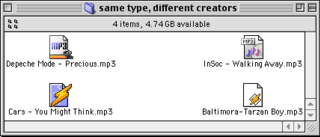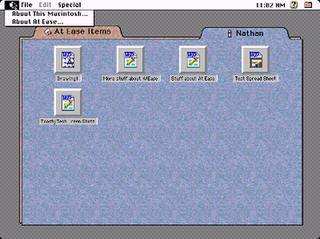Related Research Articles

AppleScript is a scripting language created by Apple Inc. that facilitates automated control over scriptable Mac applications. First introduced in System 7, it is currently included in all versions of macOS as part of a package of system automation tools. The term "AppleScript" may refer to the language itself, to an individual script written in the language, or, informally, to the macOS Open Scripting Architecture that underlies the language.
The resource fork is a fork or section of a file on Apple's classic Mac OS operating system, which was also carried over to the modern macOS for compatibility, used to store structured data along with the unstructured data stored within the data fork.

A creator code is a mechanism introduced in the classic Mac OS to link a data file to the application program which created it. The similar type code held the file type, like "TEXT". Together, the type and creator indicated what application should be used to open a file, similar to the file extensions in other operating systems.

System 7, codenamed "Big Bang", and also known as Mac OS 7, is a graphical user interface-based operating system for Macintosh computers and is part of the classic Mac OS series of operating systems. It was introduced on May 13, 1991, by Apple Computer, Inc. It succeeded System 6, and was the main Macintosh operating system until it was succeeded by Mac OS 8 in 1997. Features added with the System 7 release included virtual memory, personal file sharing, QuickTime, QuickDraw 3D, and an improved user interface.
In computing, a loadable kernel module (LKM) is an object file that contains code to extend the running kernel, or so-called base kernel, of an operating system. LKMs are typically used to add support for new hardware and/or filesystems, or for adding system calls. When the functionality provided by a LKM is no longer required, it can be unloaded in order to free memory and other resources.

FileVault is a disk encryption program in Mac OS X 10.3 (2003) and later. It performs on-the-fly encryption with volumes on Mac computers.
In classic Mac OS System 7 and later, and in macOS, an alias is a small file that represents another object in a local, remote, or removable file system and provides a dynamic link to it; the target object may be moved or renamed, and the alias will still link to it. In Windows, a "shortcut", a file with a .lnk extension, performs a similar function.
Apple Open Collaboration Environment (AOCE), is a collection of messaging-related technologies introduced for the classic Mac OS in the early 1990s. It includes the PowerTalk mail engine, which is the primary client-side interface to the system, the PowerShare mail server for workgroup installations, and a number of additional technologies such as Open Directory, encryption, and digital signature support.
These tables provide a comparison of operating systems, of computer devices, as listing general and technical information for a number of widely used and currently available PC or handheld operating systems. The article "Usage share of operating systems" provides a broader, and more general, comparison of operating systems that includes servers, mainframes and supercomputers.

Installer is an application included in macOS that extracts and installs files out of .pkg packages. It was created by NeXT, and is now maintained by Apple Inc. Its purpose is to help software developers create uniform software installers.
In computing, a file association associates a file with an application capable of opening that file. More commonly, a file association associates a class of files with a corresponding application.

At Ease was an alternative to the Macintosh desktop developed by Apple Computer in the early 1990s for the classic Mac OS. It provided a simple environment for new Macintosh users and young children to help them to work without supervision. At Ease replaces the Finder desktop, providing a simple tabbed panel-oriented graphical user interface in which applications and documents are represented by icons on large buttons. Aside from its security features, its interface and basic functionality is very similar to the Packard Bell Navigator.
In NeXTSTEP, OPENSTEP, GNUstep, and their lineal descendants macOS and iOS, a bundle is a file directory with a defined structure and file extension, allowing related files to be grouped together as a conceptually single item.
Extended file attributes are file system features that enable users to associate computer files with metadata not interpreted by the filesystem, whereas regular attributes have a purpose strictly defined by the filesystem. Unlike forks, which can usually be as large as the maximum file size, extended attributes are usually limited in size to a value significantly smaller than the maximum file size. Typical uses include storing the author of a document, the character encoding of a plain-text document, or a checksum, cryptographic hash or digital certificate, and discretionary access control information.
A Uniform Type Identifier (UTI) is a text string used on software provided by Apple Inc. to uniquely identify a given class or type of item. Apple provides built-in UTIs to identify common system objects – document or image file types, folders and application bundles, streaming data, clipping data, movie data – and allows third party developers to add their own UTIs for application-specific or proprietary uses. Support for UTIs was added in the Mac OS X 10.4 operating system, integrated into the Spotlight desktop search technology, which uses UTIs to categorize documents. One of the primary design goals of UTIs was to eliminate the ambiguities and problems associated with inferring a file's content from its MIME type, filename extension, or type or creator code.
A file format is a standard way that information is encoded for storage in a computer file. It specifies how bits are used to encode information in a digital storage medium. File formats may be either proprietary or free and may be either unpublished or open.

Mac OS X Lion is the eighth major release of Mac OS X, Apple's desktop and server operating system for Macintosh computers.

Classic Mac OS refers to the series of operating systems developed for the Macintosh family of personal computers by Apple Inc. from 1984 to 2001, starting with System 1 and ending with Mac OS 9. The Macintosh operating system is credited with having popularized the graphical user interface concept. It was included with every Macintosh that was sold during the era in which it was developed, and many updates to the system software were done in conjunction with the introduction of new Macintosh systems.

macOS Sierra is the thirteenth major release of macOS, Apple Inc.'s desktop and server operating system for Macintosh. It was the first version of the operating system issued under the June 2016 rebranding as macOS. Sierra is named after the Sierra Nevada mountain range in California and Nevada. Its major new features concern Continuity, iCloud, and windowing, as well as support for Apple Pay and Siri.
References
- 1 2 "About Bundles". Bundle Programming Guide. Apple, Inc. Retrieved 2011-03-16.
- ↑ "Document Packages". Bundle Programming Guide. Apple, Inc. Retrieved 2011-03-16.
- ↑ "System-Declared Uniform Type Identifiers". Uniform Type Identifiers Reference. Apple, Inc. Retrieved 2011-03-16.